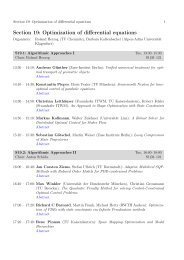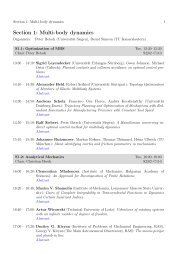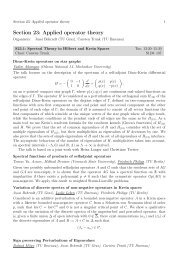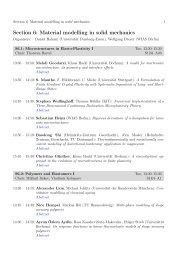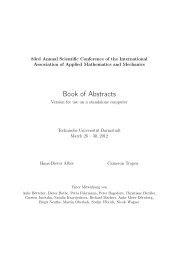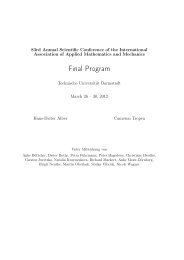Section 6: Material modelling in solid mechanics - GAMM 2012
Section 6: Material modelling in solid mechanics - GAMM 2012
Section 6: Material modelling in solid mechanics - GAMM 2012
You also want an ePaper? Increase the reach of your titles
YUMPU automatically turns print PDFs into web optimized ePapers that Google loves.
14 <strong>Section</strong> 6: <strong>Material</strong> <strong>modell<strong>in</strong>g</strong> <strong>in</strong> <strong>solid</strong> <strong>mechanics</strong><br />
[1] I. Carol and Z. Bažant, Damage and plasticity <strong>in</strong> microplane theory, Int. J. Sol. Struct. 34,<br />
3807–3835 (1997)<br />
[2] S. Gov<strong>in</strong>djee and G.J. Hall, A computational model for shape memory alloys, Int. J. Sol.<br />
Struct. 37, 735–760 (2000)<br />
[3] R. Ostwald, T. Bartel and A. Menzel, A computational micro-sphere model applied to the<br />
simulation of phase-transformations, J. Appl. Math. Mech. 90(7-8), 605–622 (2010)<br />
S6.6: Elasticity, Viscoelasticity, -plasticity I Wed, 13:30–15:30<br />
Chair: Merab Svanadze, Daniel Balzani S1|01–A1<br />
Thermoviscoplasticity deduced from enhanced rheological models<br />
Christoph Bröcker, Anton Matzenmiller (Universität Kassel)<br />
In the concept of rheological models, basic elements like spr<strong>in</strong>gs (ideal elastic), dashpots (ideal<br />
viscous) or friction elements (ideal plastic) are assembed to networks for represent<strong>in</strong>g complex<br />
material behaviour [1]. In case of viscoelastic material models, the phenomenological constitutive<br />
equations are usually deduced directly from a rheological network. However, <strong>in</strong> the case of elastoplasticity,<br />
the rheological models are often used only to visualise the fundamental structure of<br />
the related material model.<br />
In the presentation, a new ideal body is def<strong>in</strong>ed for isotropic harden<strong>in</strong>g besides m<strong>in</strong>or modifications<br />
of some well–known basic elements from the literature [2, 3]. Hence, a rheological model of<br />
thermoviscoplasticity may be assembled with l<strong>in</strong>ear isotropic and k<strong>in</strong>ematic harden<strong>in</strong>g and nonl<strong>in</strong>ear<br />
stra<strong>in</strong> rate sensitivity. The related constitutive equations <strong>in</strong>clud<strong>in</strong>g the yield function and the<br />
flow rule are directly deduced from the k<strong>in</strong>ematics and the stress equilibrium of the rheological<br />
network and results <strong>in</strong> a well–known model. By evaluat<strong>in</strong>g the dissipation <strong>in</strong>equality, the heat<br />
conduction equation is obta<strong>in</strong>ed with the dissipative power term, driven by plastic deformations.<br />
Moreover, nonl<strong>in</strong>ear isotropic and k<strong>in</strong>ematic harden<strong>in</strong>g as well as an improved description<br />
of energy storage and dissipation are accomplished by <strong>in</strong>troduc<strong>in</strong>g several additional dissipative<br />
stra<strong>in</strong> elements <strong>in</strong>to the viscoplastic arrangement of the rheological model [see also 4], which<br />
corresponds to a generalization of an ideal body already used <strong>in</strong> [2, 3]. Aga<strong>in</strong>, the constitutive<br />
equations may be deduced from the rheological network, its k<strong>in</strong>ematics, and the stress equilibrium.<br />
For that purpose, however, the dissipation <strong>in</strong>equality has to be utilized.<br />
[1] M. Re<strong>in</strong>er, Rheologie <strong>in</strong> elementarer Darstellung, Carl Hanser Verlag, 1969.<br />
[2] A. Krawietz, <strong>Material</strong>theorie, Spr<strong>in</strong>ger, 1986.<br />
[3] A. Lion, Constitutive <strong>modell<strong>in</strong>g</strong> <strong>in</strong> f<strong>in</strong>ite thermoviscoplasticity: a physical approach based on<br />
nonl<strong>in</strong>ear rheological models, Int. J. Plast. 16 (2000), 469–494.<br />
[4] A. Matzenmiller, C. Bröcker, Modell<strong>in</strong>g and simulation of coupled thermoplastic and thermoviscous<br />
structur<strong>in</strong>g and form<strong>in</strong>g processes, In: Maier et al. (eds.): Functionally graded<br />
materials <strong>in</strong> <strong>in</strong>dustrial mass production, Verlag Wissenschaftliche Skripten, Auerbach, 2009,<br />
235–250.



